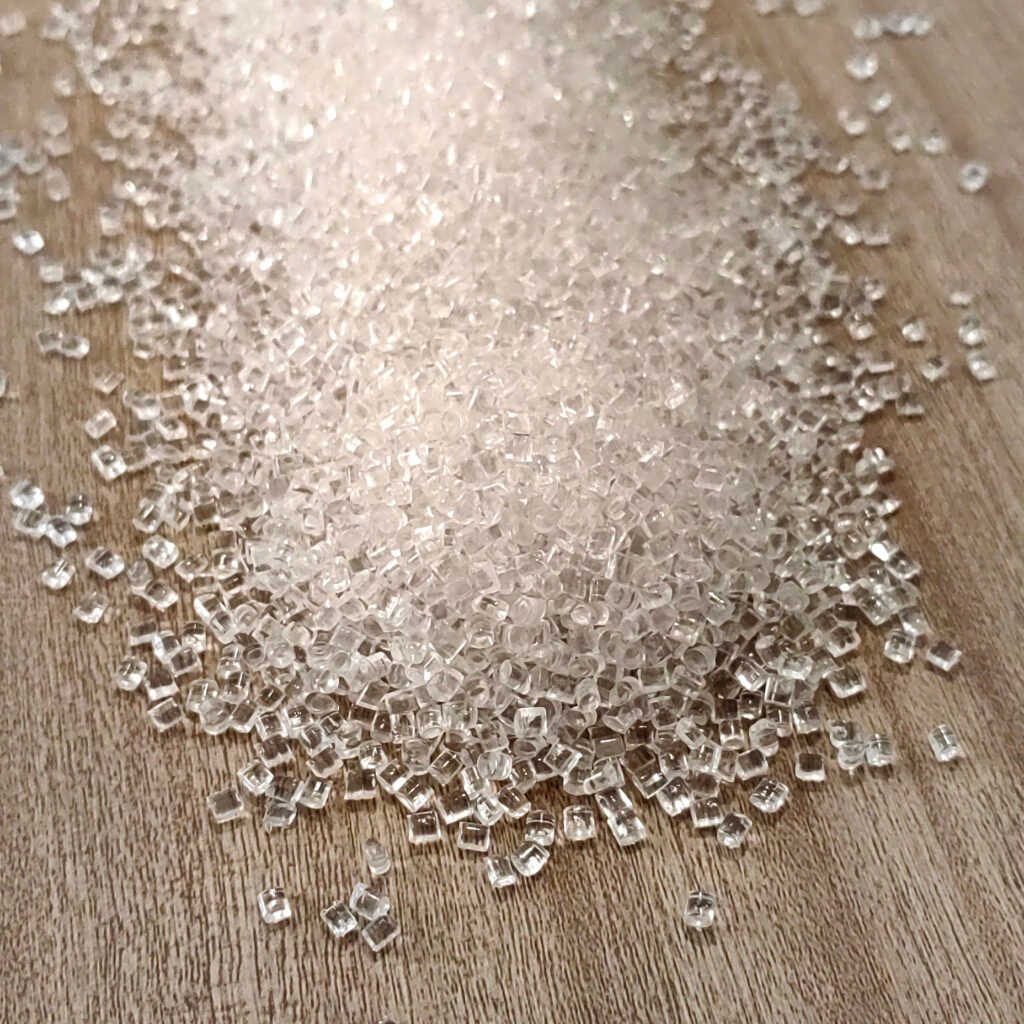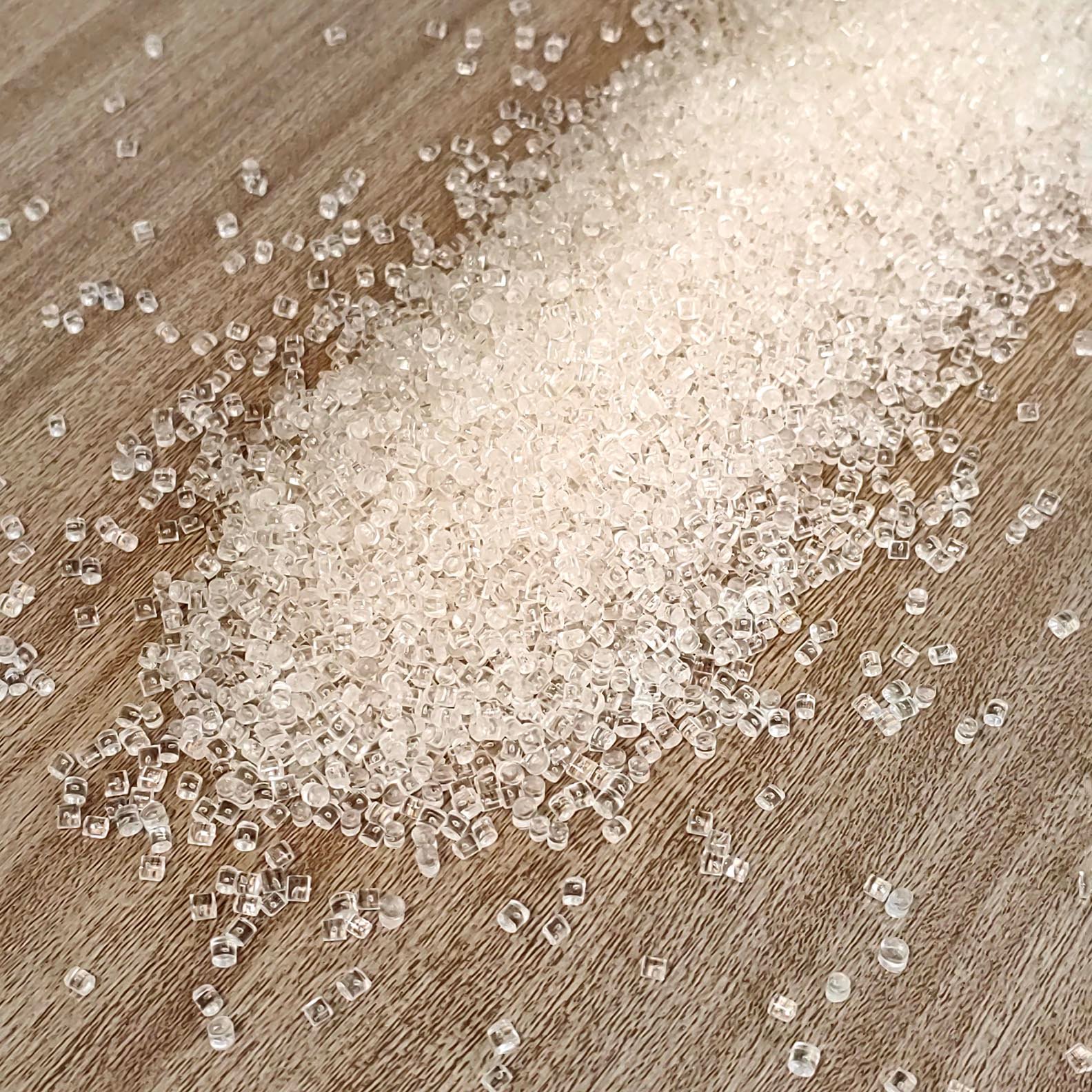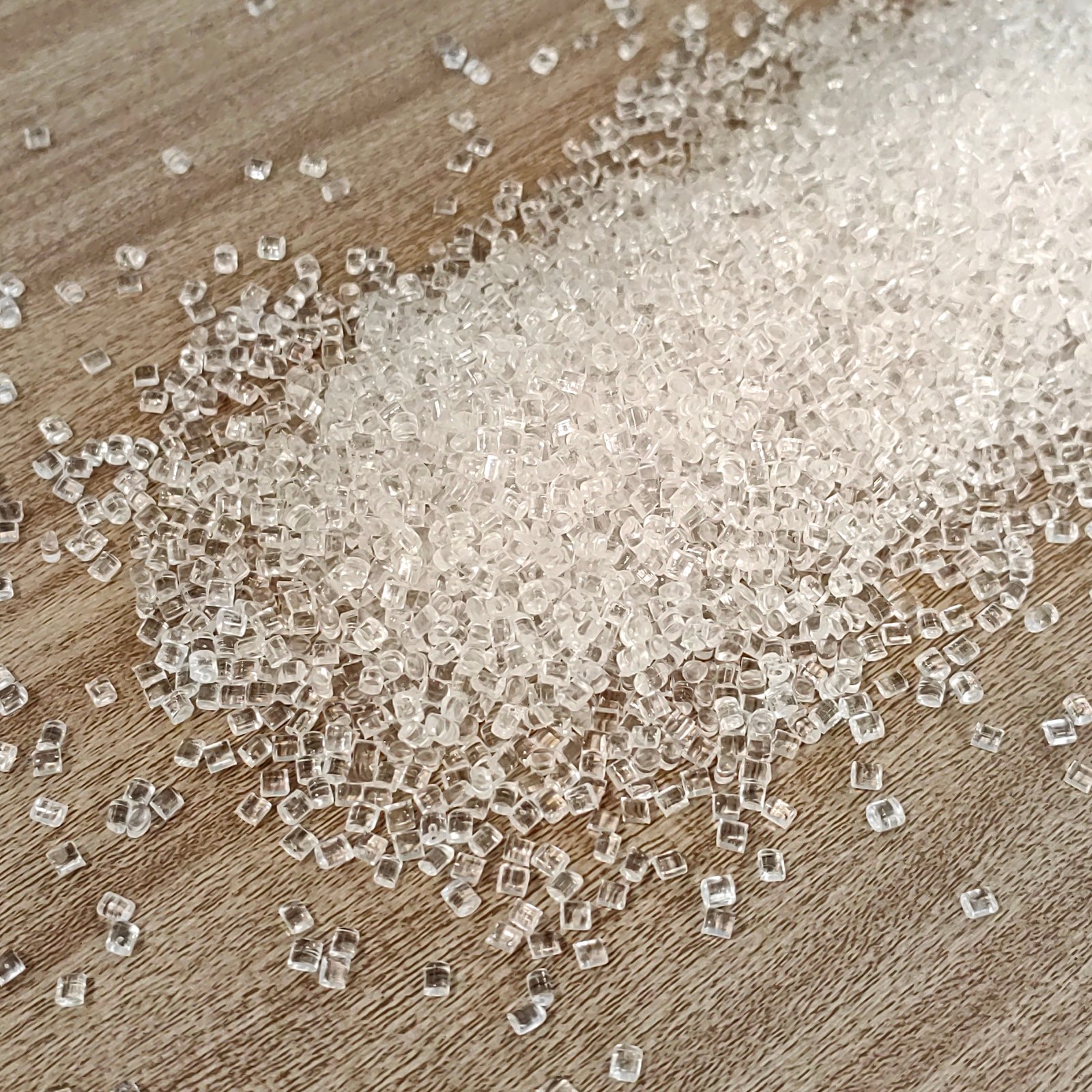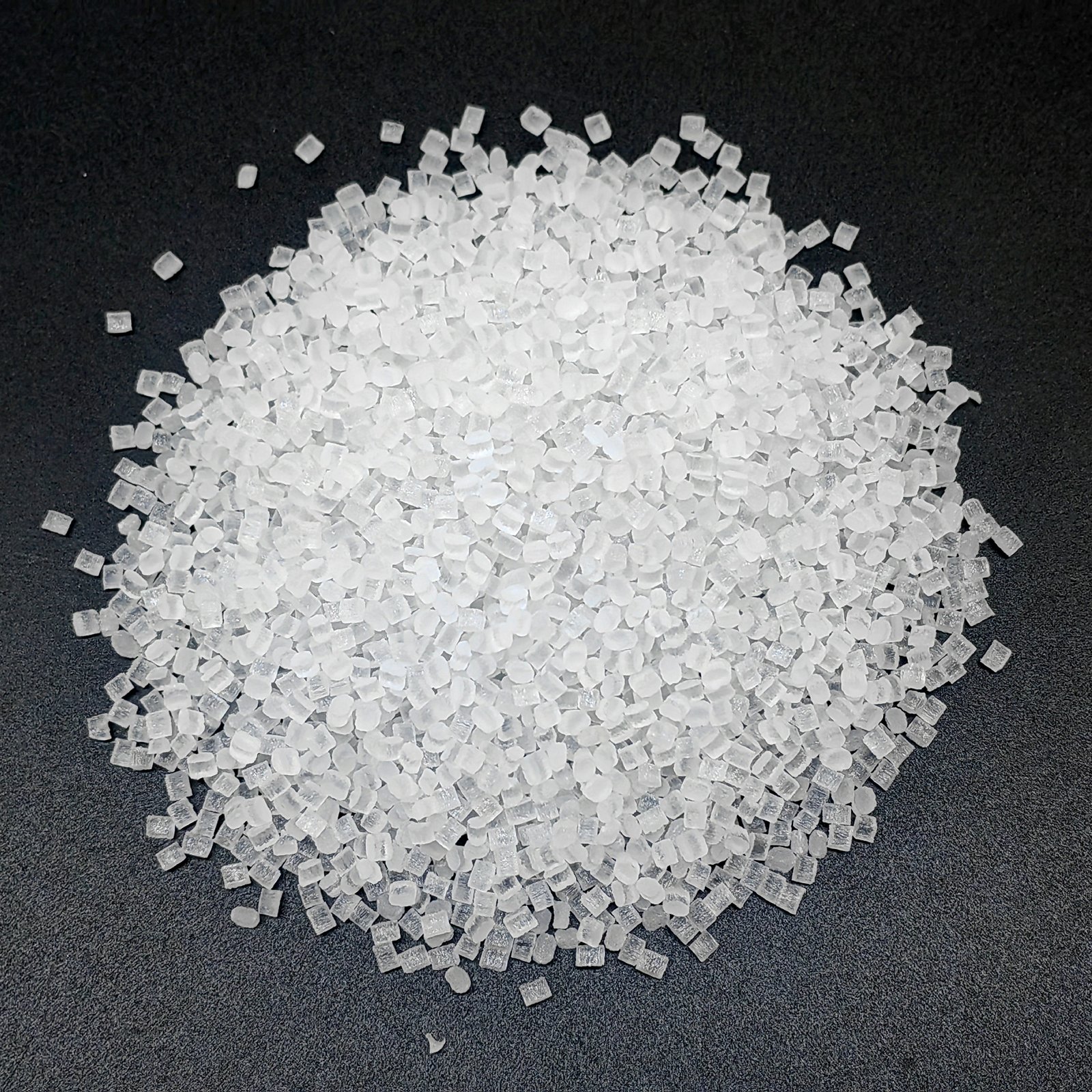PRODUCTOS


PC 1803 Heat-Resistant Polycarbonate Granule for Lighting
Estructura del producto
What are Polycarbonate Granules
PC 1803 is a high-viscosity transparent polycarbonate material designed for automotive lighting and precision injection molding. It is in the form of granules (polycarbonate granule) and is suitable for the production of thick-walled lampshades, complex light-guiding structures, and mold components with extremely high requirements for heat resistance and dimensional accuracy. It has the following features:
・The Vicat softening point is as high as 184°C, which can withstand long-term LED heat source radiation;
・Excellent dimensional stability and anti-UV aging ability;
・Supports high-precision injection molding and in-mold assembly to meet complex design requirements.

01|Industry background: Material upgrade turning point in the evolution of automotive lighting
Automotive lamps, especially LED lighting systems, are undergoing a transformation from "appearance aesthetics" to "structural composite functions". Lampshades and light guide components are no longer simple covers, but must take into account:
・High optical performance (light transmittance, refraction control)
・Structural strength and heat resistance (LED chip heat load)
・Surface stability (UV resistance, scratch resistance, long-term transparency)
Under such multiple requirements, traditional general-purpose PC materials (such as low-viscosity grades) are difficult to cope with high temperature, thick wall and precision assembly scenarios. This also promotes high-performance polycarbonate granules such as PC 1803 to become the first choice for engineers in the design and material selection stage.
02|Performance Details: Three-dimensional Balanced Solution of Heat, Light and Structure
🔸 Thermal Performance: High Temperature Resistance and No Deformation
Vicat Softening Point: 184°C
Adapt to continuous heating under LED light sources without the need for additional reinforcements or air duct structures.
Long-term thermal aging stability
By adding a thermal stabilization system, PC 1803 still maintains good optical properties and mechanical strength after aging continuously at 120°C for 1,000 hours.
🔸 Dimensional control: the core indicator of module assembly
Linear shrinkage: about 0.85%
Compared with standard general PC grades (shrinkage of about 0.9-1.2%), PC 1803 has better control capabilities and is suitable for precision structures such as snap-on positioning and sealing ring matching.
Low hygroscopicity design
Avoids dimensional changes or warping problems caused by water absorption after injection molding.
🔸 Optical stability: Coping with dual aging of UV and thermal oxygen
Embedded UV stabilizer system
Significantly reduces the yellowing index without sacrificing transparency.
High light transmittance + haze control
Applicable to optical-grade components such as fog lamp covers and light guides, while avoiding internal refraction dead angles.
🔸 Polycarbonate granule data sheet
| Propiedades electricas | Condición | Estándar | Valor | Unidad | |||
| CTI | Solución A | IEC 60112 | 450 | V | |||
| CTI | M Solution B | IEC 60112 | 100 | V | |||
| Dieléctrico | Strength 1.0mm | CEI 60243 | 35 | kilovoltios/mm | |||
| Dieléctrico | Constante 100 Hz | IEC 60250 | 2.9 | ||||
| Dieléctrico | Constante 1 MHz | IEC 60250 | 2.8 | ||||
| Disipación | Factor de 100 Hz | IEC 60250 | 0.001 | ||||
| Disipación | Factor 1 MHz | IEC 60250 | 0.008 | ||||
| Electrolytic | Corrosion | IEC 60426 | A1 | Clasificación | |||
| Superficie | Resistividad | CEI 60093 | 1E+16 | Ω | |||
| Volumen | Resistividad | CEI 60093 | 1E+15 | Ω.m | |||
| Inflamabilidad | Condición | Estándar | Valor | Unidad | |||
| Fuego | Clasificación Todos los colores 1,5 mm | UL94 | media pensión | ||||
| Fuego | Clasificación Todos los colores 3,0 mm | UL94 | media pensión | ||||
| GWFI | IEC 60695 | 850 | °C | ||||
| Limitando | Oxygen Index Method A | ISO 4589 | 25 | % | |||
| Dureza | Condición | Estándar | Valor | Unidad | |||
| Pelota | Indentation Hardness | ISO 2039 | 121 | N/mm² | |||
| Comportamiento mecánico | Condición | Estándar | Valor | Unidad | |||
| Charpy | Impacto sin muesca 23°C | ISO 179 | NÓTESE BIEN | kJ/m² | |||
| Charpy | Impacto sin muesca -30°C | ISO 179 | NÓTESE BIEN | kJ/m² | |||
| Alargamiento | Rendimiento 50 mm/min | ISO 527 | 6.8 | % | |||
| Alargamiento | Rotura 50 mm/min | ISO 527 | 50 | % | |||
| Flexión | Resistencia 2,0 mm/min | ISO 178 | 106 | MPa | |||
| Flexión | Módulo 2,0 mm/min | ISO 178 | 2400 | MPa | |||
| De tensión | Módulo 1,0 mm/min | ISO 527 | 2350 | MPa | |||
| De tensión | Rendimiento de resistencia 50 mm/min. | ISO 527 | 72 | MPa | |||
| Rendimiento óptico | Condición | Estándar | Valor | Unidad | |||
| Refractivo | Índice | ISO 489 | 1.573 | ||||
| Transmitancia | 1000.00μm | ISO 13468 | 89 | % | |||
| Propiedad fisica | Condición | Estándar | Valor | Unidad | |||
| Densidad | ISO 1183 | 1150 | kg/m³ | ||||
| Derretir | Index 330°C 2.16kg | ISO 1133 | 10 | cm³/10min | |||
| Derretir | Index 330°C 2.16kg | ISO 1133 | 10 | g/10min | |||
| Contracción | Caudal 60x60x2mm | ISO 294 | 0.85 | % | |||
| Contracción | xFlujo 60x60x2mm | ISO 294 | 0.85 | % | |||
| Agua | Absorción 23°C Saturación en agua | ISO 62 | 0.3 | % | |||
| Agua | Absorption 23°C 50RH Equilibrium | ISO 62 | 0.12 | % | |||
| Térmico | Condición | Estándar | Valor | Unidad | |||
| CLE | Flujo 23~55°C | ISO 11359 | 6.5E-5 | m/m/K | |||
| CLE | xFlujo 23~55°C | ISO 11359 | 6.5E-5 | m/m/K | |||
| HDT | 1,8MPa | ISO 75 | 158 | °C | |||
| HDT | 0,45MPa | ISO 75 | 174 | °C | |||
| vicat | Temperatura de ablandamiento 120°C/h 50N | ISO 306 | 184 | °C | |||
| UL | Condición | Estándar | Valor | Unidad | |||
| Arco | Resistencia | ASTM D495 | 5 | SOCIEDAD ANÓNIMA | |||
| Comparativo | Índice de seguimiento | IEC 60112 | 1 | SOCIEDAD ANÓNIMA | |||
| Dimensional | Estabilidad | UL746 | 0.0 | % | |||
| Hola | TODOS 1,5 mm | UL 746A | 4 | SOCIEDAD ANÓNIMA | |||
| Hola | TODOS 3,0 mm | UL 746A | 4 | SOCIEDAD ANÓNIMA | |||
| Alta Velocidad | UL 746A | 2 | SOCIEDAD ANÓNIMA | ||||
| HWI | TODOS 1,5 mm | UL 746A | 2 | SOCIEDAD ANÓNIMA | |||
| HWI | TODOS 3,0 mm | UL 746A | 2 | SOCIEDAD ANÓNIMA | |||
| Outdoor | Suitability | UL-746C | f1 | ||||
| RTI | Elec TODO 1.0mm | UL 746B | 150 | °C | |||
Haga clic aquí para descargar TDS para PC 1803

03|Polycarbonate granule's role advantage in processing technology
As a high-viscosity polycarbonate granule, PC 1803 not only has superior material properties, but also has many advantages in the injection molding process:
🔧 Support thick-walled transparent parts molding
High viscosity: prevent melt sagging or bubbles even in wall thickness molding above 3mm;
Moderate cooling speed: ensure balanced stress release and avoid "halo" phenomenon;
🔧 Controllable demolding of complex structures
Fine flow path molding capability: adapt to multi-level optical structure and micro-rib design;
Optimize demolding behavior: non-stick mold, reduce mold maintenance frequency;
🔧 Strong surface treatment compatibility
Can be sprayed, coated or laser engraved, suitable for differentiated brand customization needs.
04|Typical application scenarios and structural advantages
| Application Component | Functional Requirements | Advantages of PC 1803 |
|---|---|---|
| Headlamp lens cover | High light transmission, high heat zones | Maintains optical clarity and resists deformation under heat |
| Fog lamp bezel | High stress, impact resistance | Excellent crack resistance and uniform stress distribution |
| DRL light guide | Micro-structured surface, uniform light output | Precise flow control, ensures consistent light guidance |
| Interior ambient lamp cover | Controlled haze, paintable surface | Surface-friendly, compatible with various secondary finishes |
These parts generally use injection molding + post-processing process chain, which places high requirements on the dispersibility, stability and repeatability of polycarbonate granules, and PC 1803 meets this industrial-grade stable output demand.
05|Differentiation positioning from other polycarbonate granule
| Material Grade | Market Positioning | Key Properties | Application Suitability |
|---|---|---|---|
| PC 1803 | High-heat, thick-wall parts | High viscosity, 184°C softening point, UV stabilized | Ideal for thick-walled molded parts and structural lighting covers |
| Makrolon® 6557 | Flame-retardant optical | V-0 rating, high optical clarity | More suitable for electronic/electrical components |
| PC 2407 | General-purpose injection | Medium viscosity, easy demolding | Not suitable for high-heat or thick-walled parts |
| PC-1100U | Outdoor transparent parts | UV resistance, easy mold release | Good for exterior parts, but inferior to PC 1803 in heat resistance |
06|Juyuan advantages: precision material selection + export guarantee
Juyuan focuses on international polycarbonate granule trade and provides customers with a stable supply of polycarbonate granules, including engineering-grade polycarbonates such as PC 1803. The service advantages are as follows:
✅ Original genuine channels, quality consistency guarantee
✅ UL, RoHS, COA, TDS information can be provided
✅ Customizable packaging to meet export and high-frequency shipment needs
✅ Technical support and application suggestions are followed up simultaneously to improve material selection efficiency
Conclusion|More heat-resistant and reliable polycarbonate granule solutions
Facing increasingly stringent automotive lighting system design requirements, PC 1803 polycarbonate granule provides design engineers and manufacturers with a material solution that takes into account thermal stability, structural reliability and processing friendliness. It is not only a granular raw material, but also a key carrier to meet the design challenges of a new generation of functional lamps.
【Recomendaciones relacionadas】
In-Depth Outlook on the Global Plastic Raw Materials Market: Strategic Sourcing Amid Market Volatility Más información>
Makrolon® 6557: PC Material Solution for Precision Molding and Transparent Flame Retardancy Más información>
PC 2407 Polycarbonate Pellet | UV-Stable Transparent Injection Grade Más información>






